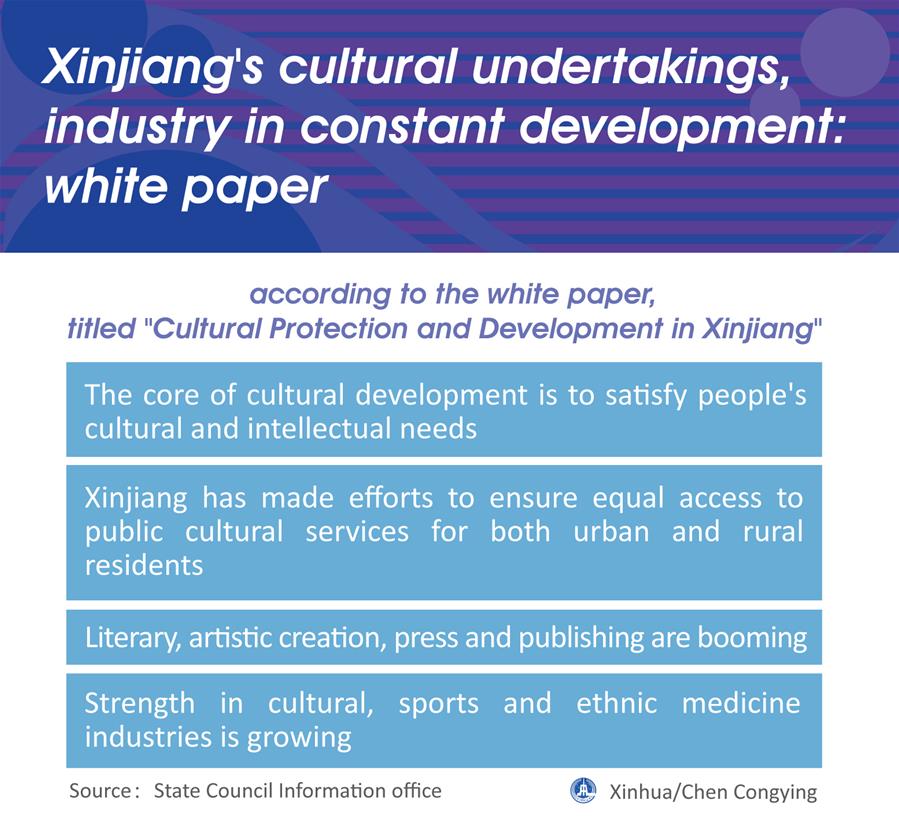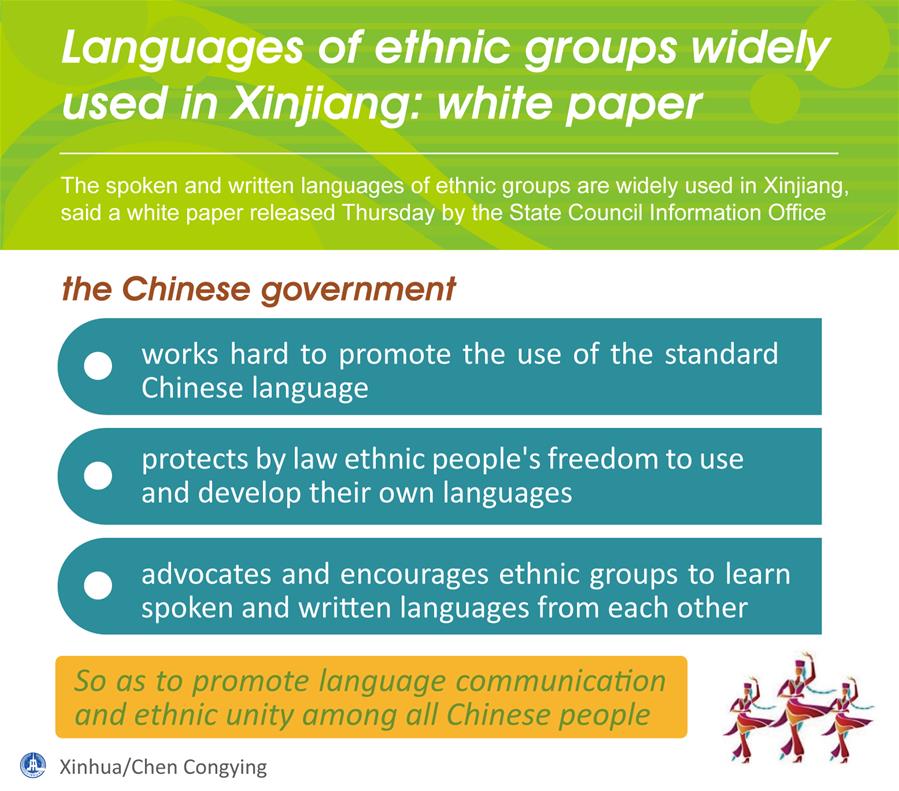China issues white paper on cultural protection, development in Xinjiang
The State Council Information Office of China on Thursday issued a white paper on cultural protection and development in Xinjiang.
The white paper, titled "Cultural Protection and Development in Xinjiang," said China is a unified multi-ethnic country. In the course of a civilization that dates back more than 5,000 years, the various ethnic groups of China have created a long history and a splendid culture.

Key points of a white paper on cultural protection and development in Xinjiang released by China's State Council Information Office on Thursday, Nov. 15, 2018. [Photo/Xinhua]
Since ancient times many ethnic groups have made their way to Xinjiang, and it has become their home and a place for cultural integration. Various ethnic cultures of Xinjiang have their roots in the fertile soil of Chinese civilization, advancing their own cultural development while enriching the overall culture of China, it said.
Since the People's Republic of China was founded in 1949, the Chinese government has attached great importance to documenting and protecting the excellent traditional ethnic cultures in Xinjiang, and ensuring that they are passed on to succeeding generations, the white paper said.
The Chinese government has promoted creative transformation and innovative development, encouraging these ethnic groups to learn spoken and written languages from each other, promoted communication and integration, respected their freedom of religious belief, and worked to develop their cultural undertakings and industries, it added.
The government has worked to modernize ethnic cultures, to strengthen cultural exchanges with foreign countries, and to enhance each group's cultural confidence while engaging in exchanges with and mutual learning from others, according to the white paper.
Sound protection
Xinjiang ethnic cultures are part of the Chinese culture, the white paper said.
Since ancient times, Xinjiang has been home to various ethnic groups, where different ethnic cultures coexist, said the white paper, noting that through many years of communication and integration, these cultures thrive in the fertile soil of China's civilization and are part of the Chinese culture.
The spoken and written languages of ethnic groups are widely used in Xinjiang, the white paper said.
It said the Chinese government works hard to promote the use of the standard Chinese language, protects by law ethnic people's freedom to use and develop their own languages, and advocates and encourages ethnic groups to learn spoken and written languages from each other, so as to promote language communication and ethnic unity among all Chinese people.
Xinjiang's religious cultures are being respected and protected.
The Chinese government is committed to protecting its citizens' freedom of religious belief while respecting and protecting religious cultures, said the white paper, adding that many religious cultures blend and coexist in Xinjiang.
Also, Xinjiang's cultural heritage is being protected and carried forward, the white paper said.
Protection of cultural heritage has yielded results, it said, adding that Xinjiang has formed a cultural heritage protection network comprising 189 institutions at all levels.
By the end of 2017, Xinjiang had 9,542 cultural heritage sites, of which six were World Heritage sites, it said.

Key points regarding the languages of ethnic groups in Xinjiang according to a white paper released by China's State Council Information Office on Thursday, Nov. 15, 2018. [Photo/Xinhua]
Constant development
The white paper also noted the constant development of cultural undertakings and the cultural industry in Xinjiang.
It said the Chinese government has given steady support to Xinjiang in its efforts to improve the quality of public cultural services, promote progress in literary and artistic creation, and press and publishing, strengthen the cultural industry, protect citizens' cultural rights, and enrich the cultural life of all ethnic groups.
The quality of public cultural services is improving.
Literary, artistic creation, press and publishing are booming, said the white paper, noting that internet culture develops rapidly in Xinjiang.
Moreover, it noted Xinjiang's active cultural exchanges with other countries.
Xinjiang has been an important gateway for China's civilization to open to the West, and has played a significant role in cultural communication and mutual learning between East and West.
Supported by the central government, Xinjiang has created a framework of cultural exchanges with other countries in all sectors and at all levels, it said.
Xinjiang participates in international cultural exchanges and cooperation in various forms, it said.
In recent years, Xinjiang has been active in building the core area along the Silk Road Economic Belt, strengthening cultural and scientific and technological exchanges with countries along the Belt, according to the white paper.

